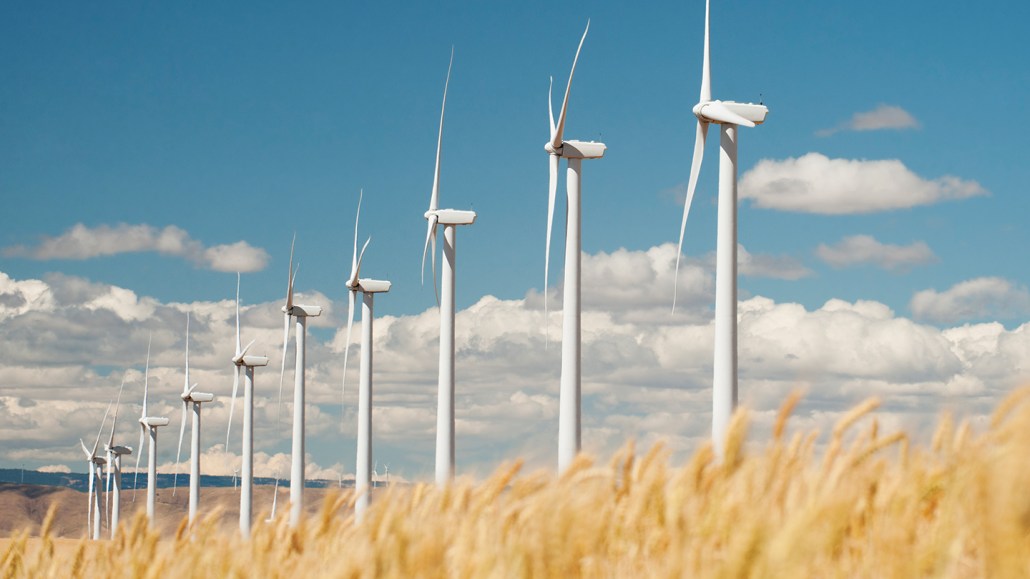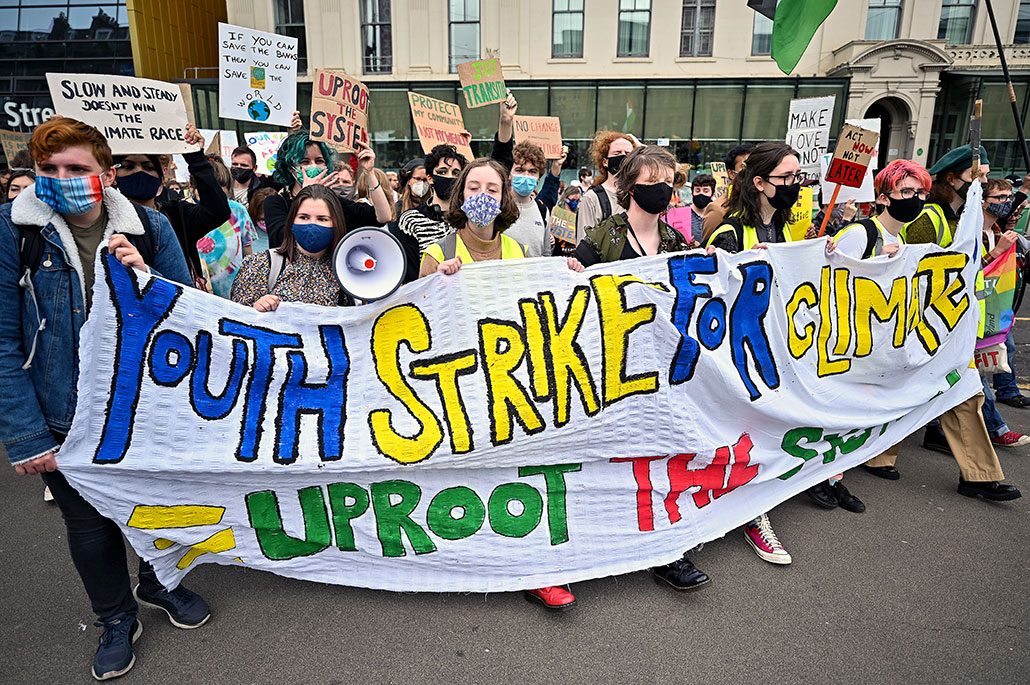The world is aiming for ‘net zero’ emissions of greenhouse gases
Countries are now charting how they might ‘decarbonize’ to get there

Curbing climate change means getting more electricity from renewable sources. Turbines such as these harness the power of wind to generate electricity.
Erik Isakson/ Tetra images/Getty Images
Share this:
- Share via email (Opens in new window) Email
- Click to share on Facebook (Opens in new window) Facebook
- Click to share on X (Opens in new window) X
- Click to share on Pinterest (Opens in new window) Pinterest
- Click to share on Reddit (Opens in new window) Reddit
- Share to Google Classroom (Opens in new window) Google Classroom
- Click to print (Opens in new window) Print
This is the first in a series of stories that will identify new technologies and actions that can slow climate change, reduce its impacts or help communities cope with a rapidly changing world.
Patricia Hidalgo-Gonzalez saw the future of energy on a broiling-hot day last September.
An email alert hit her inbox. It came from the San Diego Gas & Electric Co. “Extreme heat straining the grid,” it read. The message also pinged as a text to 27 million people. It asked customers to “save energy to help avoid power interruptions.”
And it worked.
People cut their energy use and the electric grid kept working. The campaign avoided blackouts. As a result, California successfully weathered a crisis worsened by climate change. “It was very exciting to see,” says Hidalgo-Gonzalez. An electrical engineer, she works at the University of California, San Diego. There, she studies renewable energy and the power grid.
This type of community response changes how people interact with the systems that provide us energy. And these will be crucial going forward as we figure out how to live with a changing climate.
Earth has warmed at least 1.1 degrees Celsius (2 degrees Fahrenheit) since the mid- to late-1700s. That’s when wide-scale burning of coal, oil and other fossil fuels began belching out heat-trapping greenhouse gases, such as carbon dioxide (CO2). Scientists agree that only drastic action to cut greenhouse gas emissions can keep the planet from blasting past a global warming of 1.5 degrees C (2.7 degrees F). That’s the threshold beyond which impacts become even more catastrophic than the rising sea levels and extreme weather our planet is experiencing now.
The goal is to achieve what’s known as net zero emissions — and as soon as we can. Net zero means the amount in equals the amount out. The difference between them — or net — is zero. For emissions, net zero would mean all greenhouse gases entering the air are balanced by an equal amount being removed.
Scientists say it’s possible to swiftly transform how we produce and use energy. That’s crucial to move toward a world where human activities generate little to no CO2 or other greenhouse gases. They describe this as a “decarbonized” society.
To decarbonize the future, people must shift electricity production away from fossil fuels to sources that emit little to no greenhouse gases. Think wind, solar and hydropower. Society must at the same time transform itself in other ways. Homes, vehicles and industries will have to run off those renewable sources as much as possible. And such clean electricity will also need to meet the increased needs of a growing global population.
A switch to clean electricity will cut CO2 emissions. But we will still emit some carbon. To reach net zero, we have to counterbalance those remaining emissions. That means pulling an equivalent amount of CO2 out of the air and permanently storing it somewhere.
Getting to net zero won’t be easy. It will take overcoming decades of inaction and of denying the scope of the problem. Nations are falling well short of their existing pledges to reduce emissions. As a result, global warming remains on track to charge past the 1.5-degree threshold — perhaps in as little as seven years.
Yet there is hope. Although CO2 emissions are growing globally, the rate at which they are growing has been slowing. They went up 3 percent per year in the 2000s. In the last decade or so, the yearly rate has dropped to one-sixth that amount. That’s according to the Global Carbon Project, which tallies greenhouse gas emissions.
And in the last two years, the United States — by far the biggest contributor to global warming over time — has passed several laws to give people financial benefits when they take action to move to cleaner energy.
The energy transition will require many new technologies, such as innovative ways to permanently remove carbon-based gases from the air. Other solutions already exist, such as wind and solar power.

CO2 emissions today
Of all greenhouse gases that need to be slashed, CO2 is most important. That’s because it comes from so many sources, especially cars, trucks and coal-burning power plants. In 2020, CO2 accounted for four-fifths of U.S. greenhouse gas emissions.
The next most significant greenhouse gas is methane. It comes from oil and gas operations. Livestock and landfills emit methane, too. So do other land uses.
Methane makes up just 11 percent of U.S. greenhouse gas emissions. Yet this gas is mighty. Over the short term, it is more than 80 times as efficient at trapping heat as is CO2. What’s more, methane’s atmospheric levels have nearly tripled in the last two centuries. So it plays an outsized role in warming the planet.
Other greenhouse gases include nitrous oxides. These come from activities such as applying fertilizer to crops or burning fuels. Together, nitrous oxides add up to 7 percent of U.S. emissions. Human-made fluorinated gases (such as hydrofluorocarbons) account for another 3 percent.
Large nations, which use lots of energy, release the most greenhouse gases. The United States alone emits around 5 billion metric tons of CO2 each year. For decades, it was the top annual emitter in the world. The U.S. was passed by China in the mid-2000s. India now ranks third in releases of CO2.
Many researchers and others argue that the United States should now take the global lead on cutting greenhouse gases. After all, the United States has spewed the largest share of those gases to date. It also has some of the most ambitious goals. President Joe Biden, for instance, has said the country aims to reach net zero emissions by 2050. Leaders in China have set a net zero goal for 10 years later. India hopes to reach the same goal 10 years after that.
In December 2015, an international climate treaty was drawn up. Known as the Paris accord, 193 nations plus the European Union signed on. Each pledged to reduce their releases of greenhouse gases. Their goal: to keep global warming well under a 2 degree C rise (over 1700s levels), and ideally to no more than 1.5 degrees. But even if all countries meet their pledges, the world still would likely blow past 2 degrees of warming before the end of this century.

“[Net zero] solutions are going to be country-specific,” says Sha Yu. By that she means each nation will likely find its own path. Yu is an earth scientist at the Pacific Northwest National Laboratory, or PNNL. She also works at the Joint Global Change Research Institute, in College Park, Md. (It’s run by PNNL and the University of Maryland.)
Still, there are some common themes for how nations can move to a lower-energy future. These focus on changes with the biggest impacts. And they go well beyond individual choices, such as whether we fly less or eat less meat. Instead, Yu and others note, these changes will likely penetrate every aspect of how we harness and use energy.
If society succeeds, it will rank as one of humanity’s greatest feats. We will not only have tackled a problem of our own making, but also conquered it.
Here’s a look at how we might get to net zero.
Make a lot more clean electricity
Most clean energy would be generated by technologies that already exist — renewable types, such as wind and solar power. “Renewables, far and wide, are the key pillar in any net zero scenario,” says Erin Mayfield. She’s an energy researcher at Dartmouth College in Hanover, N.H. She worked on an influential 2021 report that focused on the U.S. economy. It was produced by Princeton University’s Net Zero America project.
The Princeton report envisions wind and solar power production growing almost four-fold within the next seven years. That could set the United States on a path to reach net zero greenhouse emissions by 2050. Many new solar and wind farms would need to be built. In the most ambitious scenario, wind turbines would be visible from an area equal to the size of Arkansas, Iowa, Kansas, Missouri, Nebraska and Oklahoma combined!
Such a scale-up is only possible because prices to produce renewable energy have plunged. The cost of U.S. wind power over the last decade has dropped to less than a third of what it had been. The costs for solar power are now about a tenth of what they were. “That was a game changer,” says Hidalgo-Gonzalez of these lower costs.
Falling prices for renewable energy have led many countries to use lots more of it. China, for instance, installed a record 55 gigawatts (billion watts) of solar power in 2021. Solar now accounts for more than 306 gigawatts of the electricity generated there — nearly 13 percent of China’s total. And China was on target last year to set another solar record. For perspective, in 2020 China produced 2,380 gigawatts of electricity from all sources.
How much solar and wind power would we need?
Achieving net-zero carbon dioxide emissions would require a dramatic increase in solar and wind power in the United States. The map on the left shows where solar panels and wind turbines existed in the U.S. as of 2020. The map on the right shows where wind and solar infrastructure could exist by 2050. The gray shading shows how many people live in different areas.
Get efficient and go electric
To reach net zero, companies will have to find ways to use less energy. In addition, everyone will need to electrify as much of their lives as possible — including transportation and home heating.
Some industries are already more efficiently producing goods, such as steel. China, for instance, is turning to hydrogen-based furnaces to make steel. They’re much cleaner than coal-fired ones, notes Yu at PNNL.
In India, simply closing the least-efficient coal-fired power plants could make a huge difference, says Shayak Sengupta. He’s an energy and policy expert who works at Observer Research Foundation America. It’s a nonprofit group based in Washington, D.C. India made a list of the plants that should close first. And now, Sengupta says, “that’s been happening.”
For heating homes, electric heat pumps are much cleaner than gas- or oil-fired furnaces and boilers. To achieve net zero, the United States would need to increase its share of those heat pumps — from around 10 percent in 2020 to as much as 80 percent by 2050. That’s what the Princeton report found. Tax breaks or rebates for such heat pumps will begin rolling out this year. (They’re part of a new U.S. law called the Inflation Reduction Act.)
Shifting more vehicles to run on electricity rather than gasoline or diesel could steeply cut greenhouse gas emissions. In a major 2021 report, the U.S. National Academies of Sciences, Engineering and Medicine pointed to the value of electric cars. Making them half of all cars sold by 2030 — just seven years from now — is one of the most important moves this country could take to decarbonize. Such a ramp up in sales is not impossible. Nearly 6 in every 100 new U.S. cars bought in 2022 were electric. That’s nearly a doubling in just one year.

Make clean fuels
Some industries can’t be fully electrified today. All-electric airplanes, for instance, will probably never be feasible for long flights. Systems that still require liquid fuels will need to switch from gas, oil and other fossil fuels to low- or zero-carbon fuels.
Biofuels — ones made from plants and other biomass — are a good low-carbon example. Green plants take up CO2 as they grow. They’ll release the carbon again after they die and break down. Over their lifetime, then, such fuels are essentially net zero in terms of carbon. Conversion facilities can turn the plant material into fuels such as hydrogen. Hydrogen, in turn, can be substituted for more carbon-rich substances in many processes (such as making plastics and fertilizers). One day biofuels may even power jets.
Solar and wind power trends in the United States
The amount of electricity generated from wind and solar power in the United States has surged in the last decade. The boost was made possible in large part by drops in the costs of producing that energy.
Rein in other emissions and sop up lots more CO2
Other greenhouse gases also need to be cut to reach net zero. In the United States, one-third of methane emissions come from oil, gas and coal operations. Many are “super emitters.” These hot spots can be mapped using satellites and other types of remote sensing. Regulators might target some of these sites as the first they ask to clean up.
In 2021, the United States and the European Union unveiled what became a global methane pledge. Some 150 countries vowed to reduce emissions of this gas. However, no one enforces those pledges. And the world’s largest methane emitter — China — has not signed on.
Once emissions have been cut as much as possible, reaching net zero will mean removing and storing as much carbon — typically CO2 — as society still emits.
One solution is already in use. Carbon capture technology can collect CO2 from power plants and other industrial facilities. The gas is then pumped into storage, such as deep underground. Globally there are around 35 such operations. Together, they take some 45 million tons of CO2 out of the air each year. About 200 new plants could be operating within seven years, according to the International Energy Agency. Other technologies are being looked at, too — such as capturing CO2 and turning it to stone.
Another way to keep the carbon stored on land is to get trees and soils to sop up more. Right now, many forests are disappearing. Much of the giant Amazon rainforest, for instance, is cut down each year. “For a few countries like Brazil, preventing deforestation will be the first thing you can do [to keep carbon in trees],” Yu says.
In other areas, communities could plant more forests and protect carbon-rich soils. For instance, some farmers could grow energy-rich grasses for use in making biofuels. Other farmers might turn some cropland or pastures back into forest. It’s even possible to sprinkle crushed rock onto croplands. That can boost the rock’s natural weathering — processes that suck CO2 out of the air.
No time to waste
Transforming how we make and use energy, as rapidly as possible, is a tremendous challenge — but one that we can meet head-on.
The Princeton team estimates that the United States would need to invest at least an additional $2.5 trillion over the next 10 years to have a shot at reaching net zero by 2050. The U.S. Congress started with two large bills it passed in 2021 and 2022. Those plan to steer more than $1 trillion toward updating major parts of the nation over a decade. This money is intended to help push a bigger transition to electric appliances. It’s seen as one important way to help fight climate change.
For Mayfield, getting to net zero by 2050 is a realistic goal — at least in the United States. “I think it’s possible,” she says. “But it doesn’t mean there’s not a lot more work to be done.”






